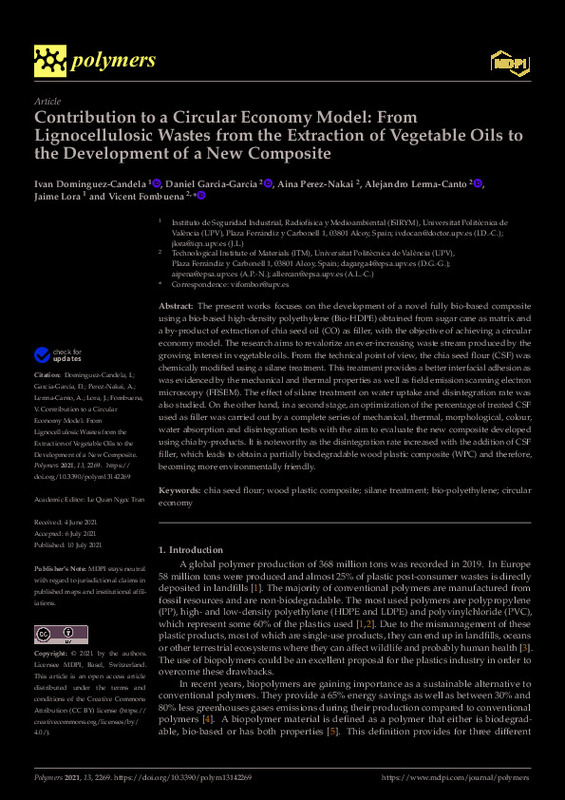JavaScript is disabled for your browser. Some features of this site may not work without it.
Buscar en RiuNet
Listar
Mi cuenta
Estadísticas
Ayuda RiuNet
Admin. UPV
Contribution to a Circular Economy Model: From LignocellulosicWastes from the Extraction of Vegetable Oils to the Development of a New Composite
Mostrar el registro sencillo del ítem
Ficheros en el ítem
| dc.contributor.author | Domínguez-Candela, Iván
|
es_ES |
| dc.contributor.author | Garcia-Garcia, Daniel
|
es_ES |
| dc.contributor.author | Lerma-Cantó, Alejandro
|
es_ES |
| dc.contributor.author | Lora-García, Jaime
|
es_ES |
| dc.contributor.author | Fombuena, Vicent
|
es_ES |
| dc.contributor.author | Perez-Nakai, Aina
|
|
| dc.date.accessioned | 2022-07-29T18:02:13Z | |
| dc.date.available | 2022-07-29T18:02:13Z | |
| dc.date.issued | 2021-07 | es_ES |
| dc.identifier.uri | http://hdl.handle.net/10251/184973 | |
| dc.description.abstract | [EN] The present works focuses on the development of a novel fully bio-based composite using a bio-based high-density polyethylene (Bio-HDPE) obtained from sugar cane as matrix and a by-product of extraction of chia seed oil (CO) as filler, with the objective of achieving a circular economy model. The research aims to revalorize an ever-increasing waste stream produced by the growing interest in vegetable oils. From the technical point of view, the chia seed flour (CSF) was chemically modified using a silane treatment. This treatment provides a better interfacial adhesion as was evidenced by the mechanical and thermal properties as well as field emission scanning electron microscopy (FESEM). The effect of silane treatment on water uptake and disintegration rate was also studied. On the other hand, in a second stage, an optimization of the percentage of treated CSF used as filler was carried out by a complete series of mechanical, thermal, morphological, colour, water absorption and disintegration tests with the aim to evaluate the new composite developed using chia by-products. It is noteworthy as the disintegration rate increased with the addition of CSF filler, which leads to obtain a partially biodegradable wood plastic composite (WPC) and therefore, becoming more environmentally friendly. | es_ES |
| dc.description.sponsorship | I. D-C wants to thank Universitat Politecnica de Valencia for his FPI grant (PAID-2019-SP20190013) and Generalitat Valenciana (GVA) for his FPI grant (ACIF/2020/233). | es_ES |
| dc.language | Inglés | es_ES |
| dc.publisher | MDPI AG | es_ES |
| dc.relation.ispartof | Polymers | es_ES |
| dc.rights | Reconocimiento (by) | es_ES |
| dc.subject | Chia seed flour | es_ES |
| dc.subject | Wood plastic composite | es_ES |
| dc.subject | Silane treatment | es_ES |
| dc.subject | Bio-polyethylene | es_ES |
| dc.subject | Circular economy | es_ES |
| dc.subject.classification | INGENIERIA QUIMICA | es_ES |
| dc.subject.classification | CIENCIA DE LOS MATERIALES E INGENIERIA METALURGICA | es_ES |
| dc.title | Contribution to a Circular Economy Model: From LignocellulosicWastes from the Extraction of Vegetable Oils to the Development of a New Composite | es_ES |
| dc.type | Artículo | es_ES |
| dc.identifier.doi | 10.3390/polym13142269 | es_ES |
| dc.relation.projectID | info:eu-repo/grantAgreement/GVA//ACIF%2F2020%2F233/ | es_ES |
| dc.relation.projectID | info:eu-repo/grantAgreement/UPV//SP20190013/ | es_ES |
| dc.relation.projectID | info:eu-repo/grantAgreement/UPV//PAID-2019/ | es_ES |
| dc.rights.accessRights | Abierto | es_ES |
| dc.contributor.affiliation | Universitat Politècnica de València. Instituto de Tecnología de Materiales - Institut de Tecnologia de Materials | es_ES |
| dc.contributor.affiliation | Universitat Politècnica de València. Departamento de Ingeniería Mecánica y de Materiales - Departament d'Enginyeria Mecànica i de Materials | es_ES |
| dc.contributor.affiliation | Universitat Politècnica de València. Departamento de Ingeniería Química y Nuclear - Departament d'Enginyeria Química i Nuclear | es_ES |
| dc.description.bibliographicCitation | Domínguez-Candela, I.; Garcia-Garcia, D.; Perez-Nakai, A.; Lerma-Cantó, A.; Lora-García, J.; Fombuena, V. (2021). Contribution to a Circular Economy Model: From LignocellulosicWastes from the Extraction of Vegetable Oils to the Development of a New Composite. Polymers. 13(14):1-26. https://doi.org/10.3390/polym13142269 | es_ES |
| dc.description.accrualMethod | S | es_ES |
| dc.relation.publisherversion | https://doi.org/10.3390/polym13142269 | es_ES |
| dc.description.upvformatpinicio | 1 | es_ES |
| dc.description.upvformatpfin | 26 | es_ES |
| dc.type.version | info:eu-repo/semantics/publishedVersion | es_ES |
| dc.description.volume | 13 | es_ES |
| dc.description.issue | 14 | es_ES |
| dc.identifier.eissn | 2073-4360 | es_ES |
| dc.identifier.pmid | 34301027 | es_ES |
| dc.identifier.pmcid | PMC8309261 | es_ES |
| dc.relation.pasarela | S\442995 | es_ES |
| dc.contributor.funder | Generalitat Valenciana | es_ES |
| dc.contributor.funder | Universitat Politècnica de València | es_ES |
| upv.costeAPC | 1532,91 | es_ES |








